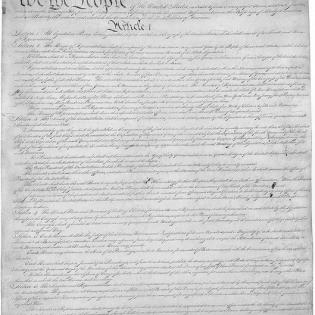Philanthropy Found in the U.S. Constitution
Students identify the components and rationale behind the Constitution, with a particular emphasis on philanthropy. This lesson is designed for Citizenship/Constitution Day (September 17) and connects students to the community-building focus of the Constitution and how it relates personally to their lives and action.
The learner will
- define philanthropy as giving something we have, know, or do for the sake of others or the common good.
- identify the Preamble, articles, and Bill of Rights in the Constitution.
- state things citizens can do to honor the words of the Constitution and make the world better.
- PowerPoint presentation or video outlining the Constitution
- student copies of the handout Constitution Questions
- Optional: student copies of Constitution Scavenger Hunt handout
- Optional: online copies of the Constitution text and Bill of Rights and Articles text
- Optional: teacher copy of Constitution Scavenger Hunt Answer Key
- Optional: student copies of Constitution and Philanthropy Vocabulary handout
Preview this video that gives an overview of the purpose and structure of the Constitution and its relationship to philanthropy. This may be used for classroom instruction or homework.
- philanthropy: giving time, talent, or treasure and taking action for the common good; doing things to help others and make the world a better place; sharing what you have, know, and do for the good of others
- Preamble: the opening statement of purpose of the U.S. Constitution
- Bill of Rights: the first ten Amendments to the Constitution; gifts of the Founding Fathers to ensure justice and the best system for diverse people
- Articles: seven sets of rules outlining a system of government that ensures a perfect union
- checks and balances: three branches of government have a balance of power to make sure none gets too much control
- perfect union: a system that is wise and will adapt and meet the needs of its citizens
- domestic tranquility: peace at home
- justice: fair treatment of all; equal opportunity and access to resources
- general welfare: what is good for all, the common good
- liberty: freedom to do what makes your life the best it can be
- posterity: what you leave behind for the future; the gifts you leave for your descendents
What can you do to make the world a better place, with the words of the Constitution in mind?
Instructions
Open up with a brief class brainstorm. On your board, write two columns with “The Constiution” on one side and “Philanthropy” on the other. Have students share what they know, or think they know, about each. Write down student responses. (8 minutes)
Then pose the questions, “Do you think these two items have anything to do with each other?” and “Why do you think the Constitution was written?” (3 minutes)
Project the Constitution Presentation PPT (handout below or video version) onto your screen and lead student through the presentation, having students take notes. Slides 9 (words of the Preamble) and 24 (adding a new amendment) are good places to pause and to have discussions with your students. (25 minutes)
Put students into groups and have them work together to answer the Constitution Questions associated with the presentation. See the handout below. Their discussion of the last question will be shared with the whole class. The handout may be turned in for an assessment. (15 minutes)
Wrap-up class. Summarize major points of the day. Discuss what we can do to make the community/world better, with the words of the Constitution in mind.
Either collect the completed handout assessment or share correct answers. (9 minutes)
The Constitution Scavenger Hunt is a fun optional group activity. See handouts below, including the scavenger hunt, answer key, and related vocabulary. You may give a prize, such as a privilege, to the group with the most correct answers or finished first. We are all winners for having a great Constitution.
Philanthropy Framework
-
Strand PHIL.II Philanthropy and Civil Society
-
Standard PCS 05. Philanthropy and Government
-
Benchmark MS.5 Describe how individual freedoms are protected by the constitution and how civil society organizations implement these rights.
-
-
-
Strand PHIL.III Philanthropy and the Individual
-
Standard PI 01. Reasons for Individual Philanthropy
-
Benchmark MS.10 Identify reasons why historic figures acted for the common good.
-
-
-
Strand PHIL.IV Volunteering and Service
-
Standard VS 01. Needs Assessment
-
Benchmark MS.1 Identify a need in the school, local community, state, nation, or world.
-
-
